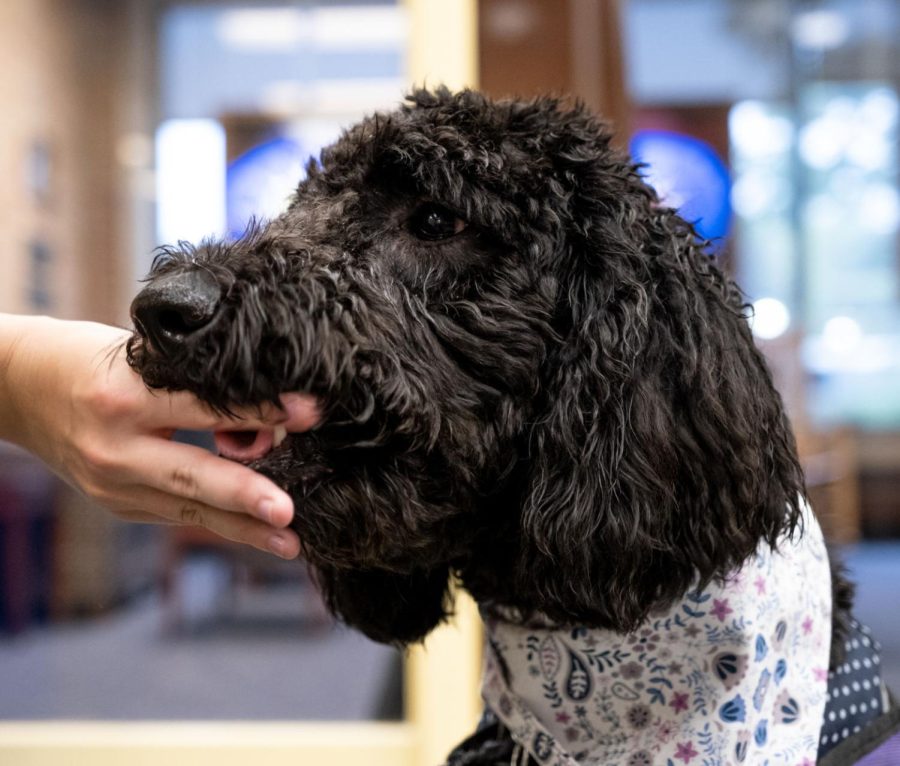Joe Biden is bringing dogs back to the White House
Sophomore journalism major Colleen Burns feeds her 7-month-old golden doodle Fendi a treat in the Kent State library on Wednesday, Oct. 2, 2019. Fendi is training to be a service dog with the on-campus organization Paws for a Cause.
November 29, 2020
Editor’s note: Alexandra Horowitz is a professor and senior research fellow at Barnard College, and author most recently of “Our Dogs Ourselves: The Story of a Singular Bond.” Views expressed in this commentary are solely hers. Read more opinion articles on CNN.
(CNN) — I witnessed a rush of collective pleasure online when the news came, on November 7, that Joe Biden had won the presidential race. Not just because of Biden, but also because of Major and Champ, the new first dogs of the United States.
The excitement was palpable because, among other reasons, these German shepherds serve as a stand-in for our national sentiment — for the optimism we’re feeling as we prepare to embark on a new chapter under a new presidential administration.
For the last four years the White House has not had the slobbery, shedding, panting presence of a dog that it so often has. Until the Trump administration, the last time the White House didn’t have a resident dog was during William McKinley’s presidency from 1897 to 1901. And despite the fact that keeping dogs didn’t start to become a true national pastime until 100 years after the beginning of the republic, two-thirds of all presidents have shared the storied hallways with a recent descendant of the gray wolf. And nearly every president since George Washington has had a presidential pet of some sort — including a ram, a cow, a badger, raccoons, and a couple parakeets.
Most recently, though, dogs have been used by President Donald Trump not as pets but as a linguistic cudgel. He famously called Omarosa Manigault Newman “that dog”, and it was not intended as a compliment about her fidelity and comeliness. He has regularly wielded the simile “like a dog” to emphatically degrade people he dislikes, tweeting that Brent Bozell of the National Review “came to my office begging for money like a dog,”and that Florida Sen. Marco Rubio was “sweating like a dog.” (Of course, this makes no sense. Dogs, who sweat only through their paws, don’t get all sweaty like we do, and if they beg for anything, it’s treats and tickles, not money.) Trump’s intent seems to have been to equate his enemies with the lowest, most disrespectable of animals — a status quite at odds with that of the contemporary American dog, some tens of millions of whom joined their people on the couch or bed watching late-night election results start to trickle in on TV on November 3.
By contrast, Biden posted a video on Instagram on October 5 of himself and Major, the rescue dog he adopted two years ago. Biden is seen smiling as Major licks his face. Major and Champ — who joined the Biden family when Joe Biden became Vice President in 2008 — are now featured on Instagram fan accounts, with thousands of followers.
The excitement over the return of dogs to the White House parallels the high rates of dog adoptions and puppy purchases during the pandemic, providing a window into our own psyches in this moment of uncertainty and stress, as we each bear the mental weight of a global public health crisis on top of ongoing political contention. Dogs, beacons of positivity, provide some relief from these burdens. Their reputation is well-earned: on the whole, dogs are naturally good-spirited. In their lives with people, most are impressively resilient after being separated — happy to see us whether we’ve left the house for three minutes or three years. They hold no grudges, tell no falsehoods and are faithful to a fault. In short, they are our better selves.
Imagining dogs in the White House makes me happy. Who doesn’t get a kick out of the images of President Theodore Roosevelt’s dog Pete chasing the French Ambassador up a tree. Thinking about Champ and Major scampering through the Biden White House, knocking over a precious lamp or two, chewing the occasional executive desk leg or soiling the rug during a long night, reminds us of the pleasures, and sometimes difficulties, of living with animals. We can understand what it’s like to be the person who comes downstairs first in the morning to discover that rug. It gives the rest of us a shared experience with the people who live in the most significant house in the country. In the coming years, we will see glimpses of the dogs following the Bidens, gazing at them as only a dog can –allowing us to breathe easily at the humanity on display.
Moreover, Biden’s adoption of Major, a dog from a shelter, is an implicit acknowledgment that even those who come from humble, perhaps disadvantaged, beginnings, can make it to the big time. Often unfairly characterized as troubled or risky, or even just unknown, shelter dogs have traditionally been less popular than bred dogs for people looking to bring a pet into their family. In the idealized view of the great American melting pot, though — one that we may indeed come closer to with time — everyone should be welcome, regardless of their origin story. And this extends to our four-legged friends.
“How would I look walking a dog on the White House lawn?” Trump said in 2019 explaining why he hadn’t gotten a dog. Well, I have a vivid picture in my head of President Obama and his family walking their dog, Bo, on the White House lawn.
How did they look? They looked magnificently and indisputably American.
The-CNN-Wire
™ & © 2020 Cable News Network, Inc., a WarnerMedia Company. All rights reserved.









